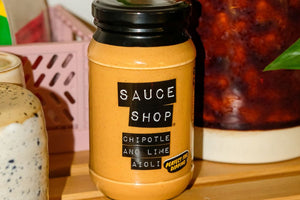Sauce experts explain: What's the difference between Mayonnaise and Aioli?
If there’s one thing we know. It’s sauce. And because of this, we also know how much sauce can transform a dish, but it’s important to use the right one to get as much as possible out of your food. This is why we have explored the difference between mayonnaise and aioli in this blog post, so you can be sure you’re using the right one for your palette and style of food.
What is Mayonnaise?
Mayonnaise is a beloved and versatile classic, one that you probably have in your fridge right now, but what actually is this beautiful sauce? Mayo is made when oil and egg combine to form an emulsion (the mixture of two or more liquids that do not naturally mix together), and vinegar is then added to help preserve the sauce, whilst also adding flavour. The neutral flavour that this creates makes it perfect for use within a variety of foods, with sandwiches, salads, and chips being the most popular pairings for mayo.
What is Aioli?
Aioli has a Mediterranean heritage and takes the same emulsifying process of mayonnaise, but with a bit of a twist. Found in foods off the Mediterranean coasts of Spain and France, aioli introduces garlic and other strong flavours to the delicious original mayo mix. While sharing the fundamental components of oil, egg yolks, and sometimes lemon juice, aioli stands out with its distinct kick. A great example of this is our Chipotle and Lime Aioli, which adds a very slight (and delicious) spice to mayo, alongside freshness with lime in the mix.
What are the Differences?
The Flavour Profile
One of the most important differences between mayonnaise and aioli is arguably, the flavour (shocking, we know). Mayo's usually quite mild and creamy, which is perfect for being able to adapt to a large variety of dishes, whereas aioli is more robust and garlicky, giving a more distinct flavour to your food.
Their Culinary Origins
Another difference between these two sauces is their culinary origins, although they’re quite similar, they’re from two different places. Mayonnaise originated from France, but has now become a global staple. Aioli however originated in Spain, although there is some debate about its exact origins.
Application
Similar to the flavour profile, another difference would be how you use these sauces. Mayonnaise has a milder flavour profile, so you could use it as a base for salads, as a spread for sandwiches, or just as a dip. Aioli is ideal however for dipping, spreading on roasted veg, or enhancing the flavours of seafood.
Are There Any Similarities?
While mayonnaise and aioli have their own distinct flavours, they share fundamental similarities:
Base Ingredients:
Both mayonnaise and aioli share the same base ingredients, oil for the creamy consistency, and egg that provides richness, whilst also acting as an emulsifier for the sauce.
Creamy Texture:
The texture of these sauces is also extremely similar, as the oil and egg yolks in both create a lovely creamy texture. Delicious.
Mayonnaise and aioli, though made from mostly the same ingredients (and both absolutely delicious), bring a uniqueness to each dish they’re added to, so it’s important to use the right one. Explore our unreal collection of mayonnaise and aiolis here today. Don’t know what to put them on? We’ve got loads of great recipes on our website, including our Mexican-Style Corn Salad Recipe, made with our very own Chipotle and Lime Aioli. Yum.


